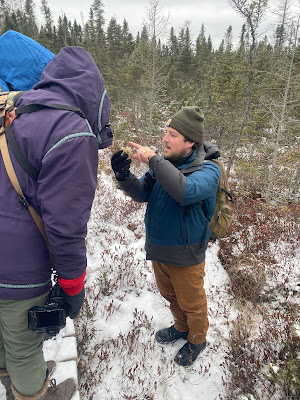Sax-Zim Bog
Over the weekend we had a crew make our way over to the bog for a field trip. Leah, Logan, Leaf, and I woke up earlier than the rest and made a detour on the way to try and see some great grays. Leaf and I feel asleep almost immediately, and the others didn't see any owls. Once we got to the bog we hit up some of the bird feeders and saw lots of species, Canada jays and an American martin were the highlights for me. Later in the morning we met up with the rest of the crew and Clinton gave us an overview of FOSZB as an organization and what they do. He brought us on a tour along the boardwalk behind the welcome center; we mostly focused on sphagnum mosses and some of the others learned about how to identify some of the common bog specialists like tamarack, black ash, leather leaf, and bog Labrador tea. We went to a couple boardwalks and ended the day looking for some great grays. Still no luck, but we did see a northern hawk owl.
While out looking around I found quite a few galls, 4 of which (Asteromyia tumifica, rose stem girdler beetle, Diplolepis spinosa, and Diplolepis triforma) were new species records for the overall Sax-Zim Bog biodiversity count. Last visit I think I added 2 or 3 species. Sam added another 2 species and Charlie added 1, bringing up the total to 3,586 species. Clinton's been keeping track of all the species recorded in the great Sax-Zim Bog ecosystem as a part of their goal of land preservation and education. It's important to know about the species behind why you're preserving land and to pass some of that information on to the public through education. 3,586 that's a lot of species! Wolf Ridge does a similar thing with our Big Year projects on iNat, since 2017 we've only observed 3,626. Still a lot of species, but our projects cover all of Lake, St. Louis, and Cook counties along with Isle Royale. Projects like this are really cool, as they often bring the focus away from the charismatic megafauna like the birds and large mammals and make you focus on the small, insignificant things. At least that's what you need to do if you want to get a lot of species. I'd rather spend my time getting people to know and care about the little things. 3,586 is the currant count of recorded species, I wonder what the actual count is... 5,000, 10,000, 1 million, 5 million, who could say? Organisms don't respect the artificial boundaries of counties, states, and whatever else us humans decide to make. Often they don't even follow the more real boundaries of ecosystems. How might the actual number of species change from year to year, or on much larger evolutionary and geologic timescales?










Comments
Post a Comment